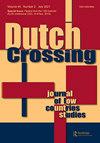The Still Life(s) of Chantal Akerman: Akerman’s Moving Images and Dutch 17th-Century Painting
IF 0.3
3区 历史学
Q1 HISTORY
Dutch Crossing-Journal of Low Countries Studies
Pub Date : 2020-05-13
DOI:10.1080/03096564.2020.1766829
引用次数: 0
Abstract
ABSTRACT Throughout her career, the Belgian filmmaker Chantal Akerman accelerated the erosion of boundaries separating the visual arts that has fuelled our current moment of mixed media. This article, though, takes different approach to Akerman’s work. It argues that her cinema borrows from a historical type of viewing experience just as much as it pioneered new ones. Specifically, I argue that Akerman drew on the painterly language of seventeenth-century Dutch still-lifes through her use of stillness, texture, space, light, and (self-)portraiture that undermines mainstream modes of visual representation as developed by Renaissance art. Relying on contemporary film theory, art history, and Akerman’s own idiosyncratic style and biography, this essay yields a productive, if unexpected, point of comparison between the aesthetic practices of early modern Dutch painting and Akerman’s moving images. Comparing several of Akerman’s pictures to a handful of masterpieces of seventeenth-century Dutch art, this work joins a growing discourse among visual theorists in exploring connections between cinema and painting more broadly.尚塔尔·阿克曼的静物:阿克曼的动态图像和17世纪荷兰绘画
在她的整个职业生涯中,比利时电影制作人尚塔尔·阿克曼(Chantal Akerman)加速了视觉艺术界限的侵蚀,这些界限推动了我们当前的混合媒体时代。然而,这篇文章对阿克曼的工作采取了不同的方法。它认为,她的电影借鉴了一种历史类型的观看体验,就像它开创了新的体验一样。具体来说,我认为阿克曼借鉴了17世纪荷兰静物画的绘画语言,通过她对静止、纹理、空间、光线和(自我)肖像的使用,破坏了文艺复兴艺术发展起来的视觉表现的主流模式。依靠当代电影理论、艺术史和阿克曼自己独特的风格和传记,这篇文章在早期现代荷兰绘画的审美实践和阿克曼的运动图像之间产生了一个富有成效的比较点,如果意想不到的话。将阿克曼的几幅作品与17世纪荷兰艺术的几幅杰作进行比较,这部作品加入了视觉理论家们越来越广泛地探讨电影和绘画之间联系的话语。
本文章由计算机程序翻译,如有差异,请以英文原文为准。
求助全文
约1分钟内获得全文
求助全文

 求助内容:
求助内容: 应助结果提醒方式:
应助结果提醒方式:


